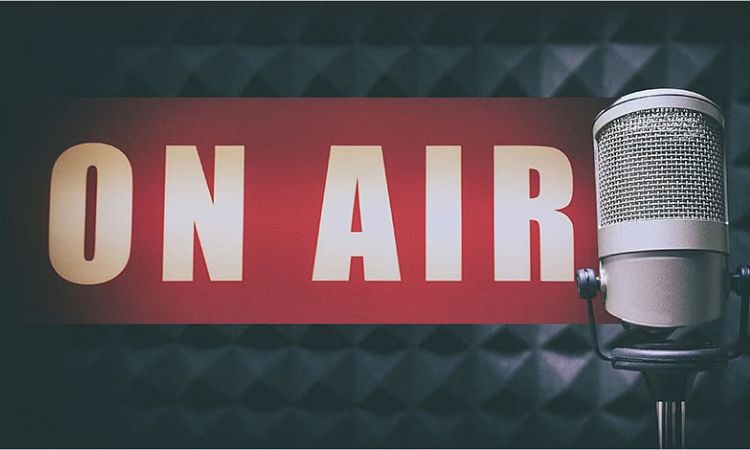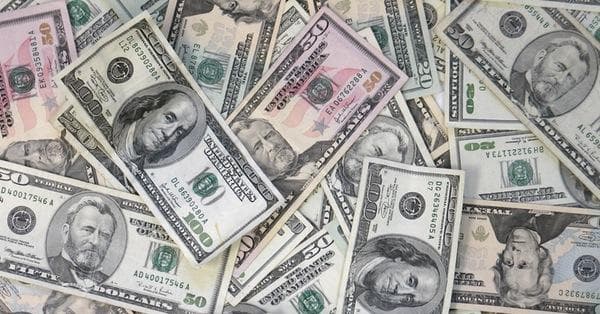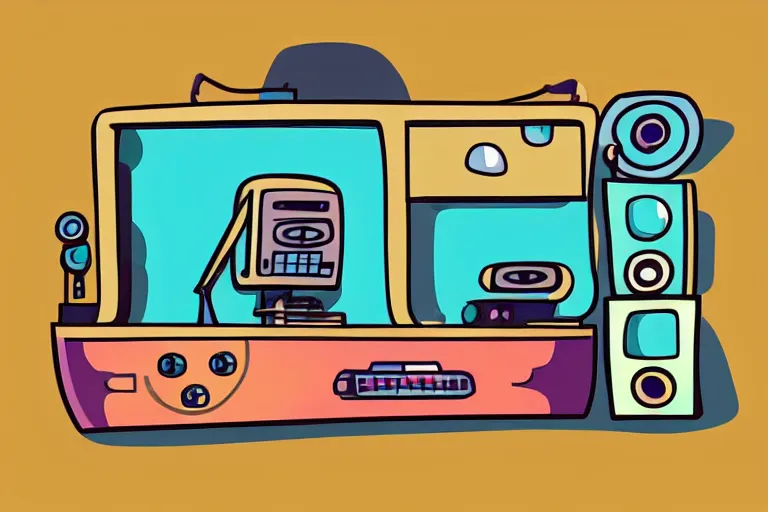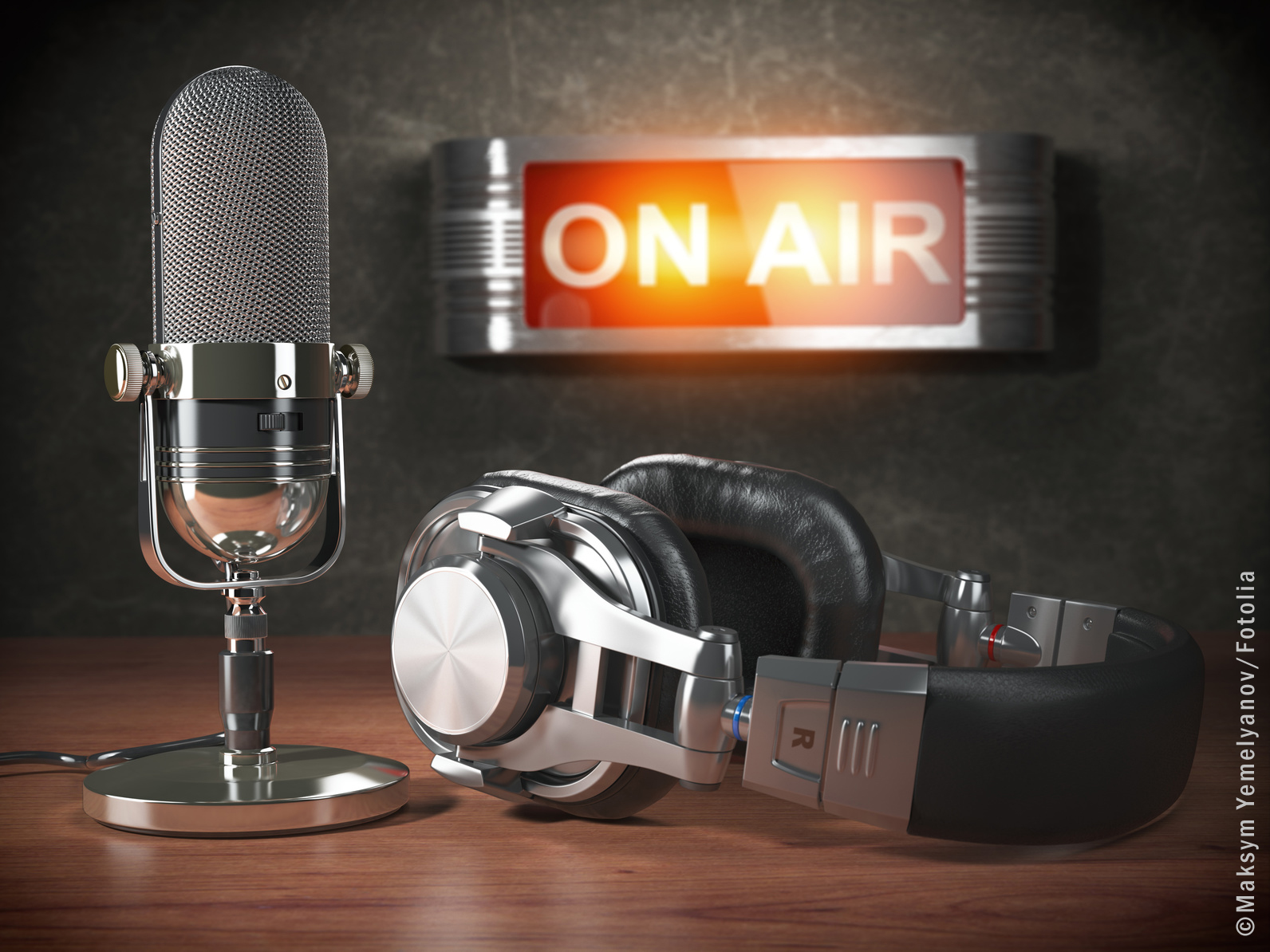
HOW RADIO LOST ITS GROOVE
In recent years, it has become obvious that radio, at least as the entity that I grew up with in my teenage and young adult years, has lost its groove. These days, the overwhelming amount of musical formats reflect the lack of imagination in an industry that once enhanced our overall enjoyment of the sounds that emanated from car radios and transistor radios (aka mobile devices from a bygone era).
Of course, there will always be a small amount of stations that are still following their own musical path and playing music they believe is important for us to hear but there just doesn't seem to be as many of them as there used to be. Sadly, commercial radio is no longer the cultural experience that it once was.

My personal experience with radio began in the early sixties during the British Invasion. Initially, I listened to sounds on my little transistor radio that was tuned into the local Top 40 AM radio station in whatever town I lived in. Later, with the advent of FM radio, the experience of discovering new music became more of a creative experience.
As AM radio developed, the aspect of payola, wherein DJ's received cash and gifts from record label promoters, had a definite impact on the personal element of music radio. "Radio DJs had a profound effect on American music in the 1950s. The “pillars of U.S. low- and middle-brow culture” according to Time magazine, disc jockeys ruled the airwaves and introduced American teenagers to rock and roll and rhythm and blues songs. But in 1960, nearly overnight, the role of DJs as a creative and cultural force was diminished. In that year, after several federal investigations into the radio business, Congress amended the Communications Act in order to eliminate payola — the pejorative term for payments from outside parties, like record companies, to radio DJs. To avoid the risk of costly litigation or expensive settlements, many station managers and music directors immediately usurped DJs’ role in determining radio playlists...Payola was an old promotional practice, dating as far back as the 1880s. A music publisher would give popular musicians or bands cash or a share of royalties to play music the publisher held the copyright for as a way of generating additional sales of sheet music. In the 1950s, payola evolved into music publishers and record labels providing cash, gifts, or royalties to radio station disc jockeys in order to gain airplay, which stimulated record sales. Then, in 1960, Congress effectively outlawed payola with an impractical disclosure requirement." (Radio Rock website)

Yesterday, I happened to come across an article called Whatever Happened To Rock & Roll Radio on CNN that really captured a lot of the feelings I’ve been having about the overall destruction of quality rock & roll radio.
WHATEVER HAPPENED TO ROCK & ROLL RADIO?
In the beginning, there was AM Top Forty radio. It played the Big Boss Sounds and the Platters That Mattered, Motown and Merseybeat, folk-rock and Frank Sinatra, girl groups and garage bands and the Beatles, the Stones and 1, 2, 3, Red Light, and you could hear it across the land with 50,000 mighty watts from W-A-Beatle-C in New York to WLS in Chicago to KHJ in L.A. And the people listened, and it was good. Then came free-form progressive radio, and it played the groovy tracks, LP versions of your singles, and the flow of sounds would feature Miles Davis into Pink Floyd into Carole King into Van Morrison. The DJ's would put on adventurous sets where only the DJ knew what was coming next, and it was very inventive, and that became a whole new thing.
Sadly, the DJ's artistry was taken out of the equation as rock & roll radio became just another bland corporate bottom line. By the late '60s, the rock radio was suddenly began to change. Singles were forced to make room for albums, and free-form, a new style of radio, was making inroads on the once-neglected FM side of the dial..
Suddenly, FM radio became more profitable, the stations -- and their corporate owners -- started playing it safe. Consultants began darkening the doorways of FM stations as they asked for specific demographics in order to homogenize the music.

1980s and 1990s college radio stations were champions of independent music. Listeners bored with the predictable offerings of mainstream stations could turn to college radio for a wide range of genres curated into specialty shows. The DJs, though housed in the nooks, crannies and spare rooms of American campus buildings, were knowledgeable and immersed in their local music scenes. They often booked and promoted shows: it was how bands such as R.E.M. and Nirvana were discovered.

As AM radio became more regulated, the rise of FM radio returned a creative atmosphere for many music fans.

Danny Goldberg
In his excellent memoir, Bumping Into Geniuses: My Life Inside The Rock and Roll Business (Gotham, 2008), Danny Goldberg captures some of the immediacy of how radio morphed into free form FM programming:

“Top 40 had helped launch the Beatles and the rest of the British invasion in 1964, but to teenagers, 1967 was not three years but three lifetimes later…The underground radio format was created by a former Top 40 DJ named Tom Donahue, whom I first heard on KMPX in Berkeley in the fall of 1967, several months after he had the epiphany that there was an audience for an eclectic flow of rock albums, blues, and jazz, with an occasional classical record thrown into the mix. KMPX played multiple songs from albums, not just the singles. The DJs were emotional about the music and they spoke informally, as if they had just smoked a joint, which many of them had…In early 1968, after a dispute with the owners of KMPX, Donahue and the entire staff took their format to a station owned by Metromedia and rechristened it KSAN…The Metromedia chain soon adapted the underground format in New York (WNEW), Philadelphia (WMMR), and Los Angeles (KMET).
Over the years, the true essence of radio began to change as the media became driven solely by demographics. The magic of FM radio's free form approach began to disappear into the ether. When I began writing this blog post, I asked myself, “How did radio lose its groove?”

I think I found part of the answer to that question when I recently read a book titled The Song Machine: Inside The Hit Factory by John Seabrook which aptly describes the transition radio underwent in the 1990’s:
“1996 was the year the US Congress passed the Telecommunications Act, a major piece of legislation aimed at deregulating the media industry. The Internet had created previously unimagined opportunities for new media companies, but only if deregulation allowed them to flourish, went the argument.

One of the many changes the law brought was to raise the number of radio stations a single entity could own. Before the Telecommunications Act, radio station ownership was capped at forty – twenty AM stations, and twenty FM stations – with no more than two stations in any one market. The act did away with the national market cap entirely, and raised the local cap to a maximum of eight, depending on the size of the market. Part of the rationale was that by creating large nationwide radio networks, individual stations would be able to command higher national advertising rates, which would assist financially struggling broadcasters. Within only a few years of the passage of the act, two broadcast companies, Clear Channel and Infinity Broadcasting, had grown into Goliaths, acquiring hundreds of stations across the country.

By 2001, Clear Channel had swelled from forty stations to 1,240. Advertising rates did indeed rise, but the interest on the debt that these companies took on to make acquisitions offset the increased profits. Prior to the act, programming a radio station had been a regional art. Local disc jockeys and program directors took seriously their responsibility as curators, introducing under-the-radar songs to their listeners. Taste and instinct were as important as research in choosing what songs to play. But with the creation of coast-to-coast chains, national playlists could be devised for all stations within a particular format. This one-size-fits-all approach led to widespread complaints about homogenized programming and research-driven playlists….An academic study commissioned by the FCC five years after the Telecommunications Act passed found that the number of unique songs played on a representative sampling of radio stations actually increased in some formats – namely urban, country, and alternative. But other formats saw a significant decrease in diversity, and one of the least diverse was contemporary hits radio – that is, Top 40.”

With the disappearance of quality commercial radio, many listeners gravitated to college radio where the programming style still retained a creative bent. In recent years, I had begun to notice a disturbing one-size-fits-all ideology that has begun to infiltrate many of the college stations that have had their broadcasting licenses purchased and subsequently turned into outlets of the National Public Radio conglomerate.
An article in New Republic magazine by Ian Svenonius called The Rise and Fall of College Rock explains how a significant portion of college radio stations have become infected with the same formulaic approach as commercial radio. Here are some relevant excerpts from the article:

"Of all the types of rock music, perhaps the one that is least considered and most overlooked is college rock. Like today’s indie rock, it was named for the circumstance of its proliferation, rather than some characteristic or aesthetic of the music (such as heavy metal, noise, punk, grind, et al)…The genre wasn’t called college rock because it was produced exclusively for or by students but was instead named for the radio stations which were its champion and proponent. In the sixties, when FM radio was less typical, the FCC issued many Class D radio licenses to universities, which allowed them to create noncommercial stations on the little-used left side of dial (typically 88.1–90.5 FM. As opposed to commercial stations, which were committed to a highly restrictive Top 40 format, college radio was fairly free-form in its programming. College stations saw promulgation of lesser-heard groups as their responsibility; their sacred mission… Simultaneous to the college rock phenomenon, the yuppie archetype of monied liberal connoisseur had been developed—a foil to lingering post-60s leftist boomers…Central to the yuppie ideology was mature pragmatism; activism, communes, and protest weren’t pragmatic and carried few palpable dividends. Making lots of money, though, was considered very pragmatic. As yuppie tenets became codified during the eighties, its adherents needed a mouthpiece through which to promulgate their values, spread their seed, communicate to one another, and also define themselves…NPR, a public radio project of LBJ’s Great Society legislation, was chosen as their party organ. NPR grew muscle through generous donations by well-heeled corporate sponsors (Joan Kroc of McDonald’s donated $250 million, for example) and set to work colonizing station after station at the end of the dial—right where the college stations traditionally hovered…Claiming they were a detriment to broadcasting, NPR lobbied aggressively to destroy these small-fry noncommercial competitors, who were often forced to disband or convert to closed-circuit (campus-only) format. By the early nineties, college radio was squeezed to pathetic micropower status. Bullied and pummeled by All Things Considered, it ceased to exist as a variant to mainstream radio rock. An entire class of groups was disenfranchised, cut off from the casual listeners who wanted an alternative to the hair metal/R&B/classic rock triumvirate…”

Corporate behemoths that swallow up stations impose one-size-fits-all philosophies that ignore what works locally. DJ-by-market-research leads to oft-repeated playlists and pink slips for live-and-local talent to make way for piped-in hosts. It’s impersonal, distant, and sounds like everything else. Like Starbucks, Walmart, and Applebee’s, homogenization makes your town like every other town. Homogenization not only operates under the assumption that Chicago is Sacramento is Detroit is Savannah, but it brings that assumption closer to reality.
Diversity and distinction yield to conformity and blah. When gray-haired guys in grayer suits effectively become the DJ, they effectively force listeners into do-it-yourself-DJ mode. Pandora, iTunes, and YouTube have democratized listening. But this isn’t all for the good. The disc jockey, who presumably gained his position by superior musical knowledge, is an authoritarian whose overthrow has hurt his subjects. King Radio is now computer algorithms and opinion research. It’s hard enough for the listener to connect to an automaton pretending to be a DJ. The listener certainly can’t connect to a voiceless computer program determining tracks. The playlist is to radio what “press 7 for…” is to customer service.
As the years have rolled on the corporate ownership of rock radio stations has watered down the genre. In my opinion, one of the worst disasters of rock radio was the rise of "Classic Rock" radio stations. Those stations pretty much treat the rock genre as a frozen in time music genre. The stations merely play the same 4 songs for each "classic" band; never giving the listener what they most cherish...the opportunity to discover NEW rock music.

WHY CLASSIC ROCK ISN'T WHAT IT USED TO BE
"No one starts a band with the intention of becoming classic rock. It’s just sort of something that happens. Figuring out which genre a band fits into — is it techno or house? — has always been a tricky part of the music business. Identifying what’s classic rock is particularly challenging because it’s a constantly moving target, with very different kinds of music lumped together under the same banner. How the people who choose what music you hear — whether on the radio or an Internet streaming service — go about solving this problem reveals a deep connection between data and music.
To see what the current state of classic rock in the United States looks like, I monitored 25 classic rock radio stations1 operating in 30 of the country’s largest metropolitan areas for a week in June.2 The result, after some substantial data cleaning, was a list of 2,230 unique songs by 475 unique artists, with a total record of 37,665 coded song plays across the stations.
I found that classic rock is more than just music from a certain era, and that it changes depending on where you live. What plays in New York — a disproportionate amount of Billy Joel, for example — won’t necessarily fly in San Antonio, which prefers Mötley Crüe. Classic rock is heavily influenced by region, and in ways that are unexpected. For example, Los Angeles is playing Pearl Jam, a band most popular in the 1990s, five times more frequently than the rest of the country. Boston is playing the ’70s-era Allman Brothers six times more frequently.
To see what the current state of classic rock in the United States looks like, I monitored 25 classic rock radio stations1 operating in 30 of the country’s largest metropolitan areas for a week in June.2 The result, after some substantial data cleaning, was a list of 2,230 unique songs by 475 unique artists, with a total record of 37,665 coded song plays across the stations. I found that classic rock is more than just music from a certain era, and that it changes depending on where you live. What plays in New York — a disproportionate amount of Billy Joel, for example — won’t necessarily fly in San Antonio, which prefers Mötley Crüe. Classic rock is heavily influenced by region, and in ways that are unexpected. For example, Los Angeles is playing Pearl Jam, a band most popular in the 1990s, five times more frequently than the rest of the country. Boston is playing the ’70s-era Allman Brothers six times more frequently.
The 10-year period from 1973 to 1982 accounts for a whopping 57 percent of all song plays in the set.

Green Day
Besides a small trickle of music from 1995 onward — a trickle to which the Green Day song that inspired this article belongs — the last year to make an actual dent in the listings is 1991. That’s largely due to releases by Nirvana, Metallica and U2, the groups that make up the last wave of what is currently considered classic rock.
But clearly it’s not just when a song was released that makes it classic rock. Popularity matters, as does as a band’s longevity, its sound and a bunch of other factors. To find out why some artists are considered classic rock, I spoke to Eric Wellman, the classic rock brand manager for Clear Channel, which owns nine of the 25 radio stations in our data set. He’s also the programming director at New York’s classic rock station, WAXQ. Wellman said release years have nothing to do with what makes a song “classic rock”; the ability of the genre to grow based on consumers’ tastes is one of the things that’s given it such longevity.

In fact, radio stations are using data to make their selection decisions. Wellman said any radio company with the resources conducts regular studies in its major markets to find out what its listeners consider classic rock. And so it’s you, the consumer, who’s helping to define the genre.
The standard in the industry these days is an online music test or an auditorium music test where you just gather a sample and have them rate songs based on the hooks — the most familiar parts of the song — and you just get back a whole slew of data,” Wellman said. The stations find a cluster of people who like the music that makes up the core of classic rock, and then finds out what else they like. They like R.E.M.? Well, R.E.M. is now classic rock.
Every station has its own character, informed by its audience’s preferences. Classic rock stations do a massive amount of market research to understand who their listeners are and to figure out what songs to play.
Cities where rock stations have longer legacies, like Detroit and Philadelphia, tend to prefer an older style of classic rock — think J. Geils Band and the Beatles — while cities without that history tend to favor the more contemporary set.
But do radio stations rely at all on the institutional knowledge of their DJs to decide what to play? Nope. For the most part, the role of the song-picking DJ is dead.

So what's next for Classic Rock? It’s going to come down to economics. As baby boomers and Gen X-ers age out of the key advertising demographic over the next five to 10 years, one of two things will happen. Either advertisers will chase them, or classic rock will start to skew younger." (musicunloaded.com)

WHY CLASSIC ROCK KILLED ROCK RADIO
"There are a number of factors behind the precipitous rise and musical freefall of Modern Rock radio, and they're as predictable as a new Sponge single. As alternative rock became a dominant commercial force, more and more stations quickly jumped on the band wagon. What began as a handful of quirky stations attempting to define themselves against the mainstream has become a sumo wrestling match between radio conglomerates desperate for ratings and intent on shaping rock's newest mainstream. But Modern Rock -- the radio format and the music itself -- wasn't really up for the fight, and so listeners have been left to suffer with stations that have about as much personality and originality as the acts they heavily, ceaselessly rotate. How is Modern Rock radio defined in 1998? Mostly by songs that are bigger stars than the here-today, gone-tomorrow artists who perform them: "Walking on the Sun" (Smash Mouth), "Push" (Matchbox 20), "Come On Eileen" (Save Ferris), "Fly"' (Sugar Ray).

Modern Rock programmers say it's the music's fault. “By the time we played Smells Like Teen Spirit for the thousandth time, it didn't smell so good any more.”
Six years ago, Modern Rock radio seemed so promising. Sure, stations were too devoted to white boys with guitars, but didn't bands such as Nirvana and Pearl Jam rewrite expectations about what commercial music could be? More than a musical revolution, the battle since has mostly been fought over ratings, and by extension, ad revenues.

Modern Rock stations that were lucky to own two percent of the listening audience in 1991 now find themselves desperate to hold onto a less loyal audience twice that size. Most have done this by tightening their playlists to 35 or 40 of the surest hit singles, and embracing softer, more mainstream artists -- the Wallflowers, Jewel -- who never would have qualified as Modern Rock six years ago.
At a typical station, only three new songs are added each week. Over the past five years, the number of singles competing for those slots has grown dramatically, as record labels have scrambled to cash in on the Modern Rock boom. A&M Records Chairman and CEO Al Cafaro, a former radio promotion executive, "The record industry has consistently gone for the short term."
How to determine whether to stick with a song or not: the number of phone-in requests, local CD sales as tracked each week by SoundScan, and call-out research, in which listeners are asked to rate songs for favorability, familiarity, and burnout. Programmers always add that gut instinct factors in somehow, but it's hard to imagine it being a match for the mathematical certainties of market research.
Does this sound bloodless? It is, and never more so than now. Radio stations once used index card systems, with each song coded for tempo, style, end frequency of play. Music directors spent entire afternoons planning the next day's log, a run sheet plotting out which songs would play when, what ads would play in between -- even those spaces where DJs could speak. It was a slow, archaic system, but it was human and open to quiet subversion by DJs who might misplace an Alanis Morissette card, or mistakenly play two red songs in a row.

Today, almost every station uses a software program -- the most common is called Selector -- which requires music directors to code each song as before, but sequences a station's playlist by computer.

My personal take on all of this is that I think the overall tenor of the times we live in reflects the lack of imagination that currently exists in our radio culture. While there are still some stations that are broadcasting music that is not driven by demographic data (particularly on the web), the bulk of the sounds strike me as nothing more than sonic fast food. With the corporate consolidation of major record labels, radio chains and concert venues, a vital sense of individualism seems to have been lost. There once was a time when the music on the radio was a daring adventure for both the listener and the broadcaster.

These are the radio stations I Listen To the most…
WEVL I Recommend Friday 4 pm - 6 pm New Orleans sounds!

JOIN THE ROCK & ROLL IS A STATE OF MIND


FREELANCE VANDALS 1979 WBAB SHOW @ THE SILVER DOLLAR SALOON
AVAILABLE NOW @ FREELANCE VANDALS MUSIC

It was a drizzly foggy night on Thanksgiving Eve 1979. The aura of tryptophan mixed with beer, cheap booze and hormones filled the Silver Dollar Saloon as the Freelance Vandals took the stage. WBAB, a popular radio station, was on hand to capture the band's first radio show!